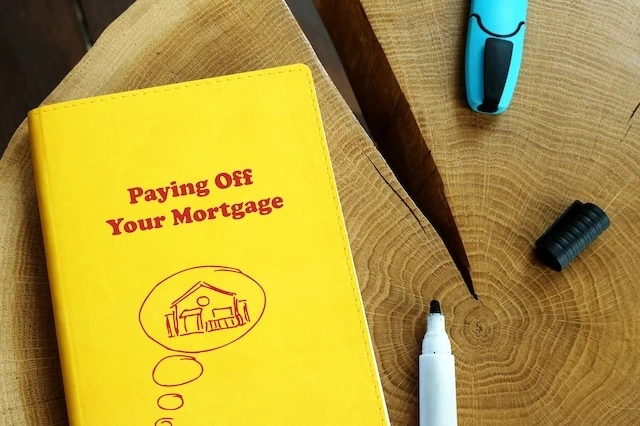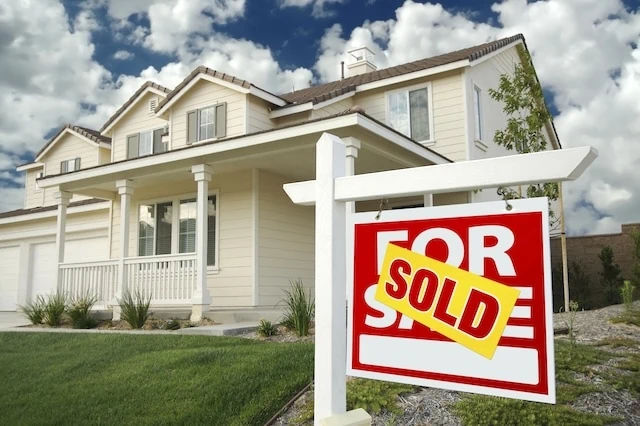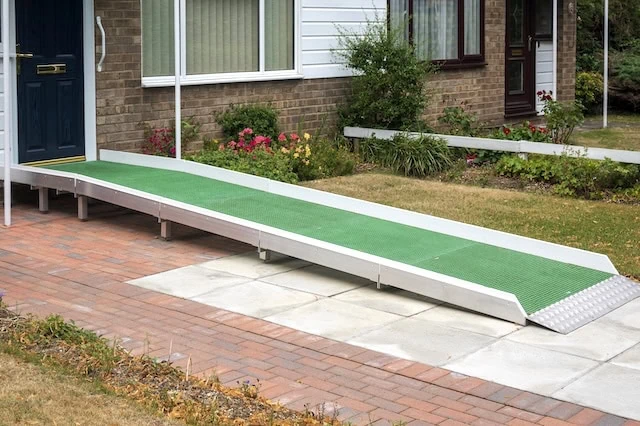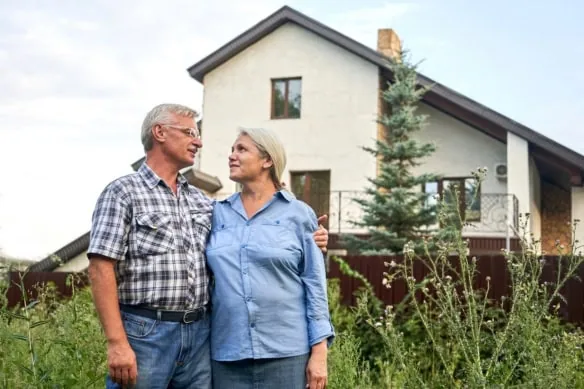“You should move into a smaller house.”
If every new retiree had a nickel for every time a family member or friend suggested the above … well, they’d have a lot of nickels. It’s accepted wisdom that people love to dole out—now that you’re retired, maybe you don’t need so much space, or don’t need to maintain so much house, or shouldn’t foot such a high mortgage or rent, or could use the break on property taxes.
All valid arguments! Not to mention, selling a larger home could finance the purchase of a smaller home and generate a tidy profit that could help fund a better retirement.
And yet … many Baby Boomers prefer to stay right where they are, in a glut of square footage.
It’s not for nothing. Today, I’m going to review some of the top reasons Baby Boomers may be reluctant to downsize their homes.
Why Baby Boomers Are Hesitant to Downsize

In early 2024, Redfin released a report about ownership of large homes, defined as those with three or more bedrooms.
I don’t think anyone would be surprised to find that Baby Boomers were the biggest owner of large homes by generation, at 37%. They’re the single largest purchase most people will make in their lives, and you typically have to be at least somewhat far along in your career to be able to afford one.
But a little more interesting is this: Empty-nest Boomers own 28% of the nation’s large homes, while Millennials with kids own just 14%.
I point out this juxtaposition because it educates one of the most common thoughts we have about retirees in large homes. “You don’t need this much home—you don’t have kids that live with you!”
That might very well be true. But don’t mistake Boomers’ insistence on staying put as selfishness. There are a number of financial, logistical, and emotional reasons why older adults keep their big homes.
Let’s dig in.
1. Capital Gains Taxes

Generally speaking, if you sell an asset and make a profit (aka, a capital gain), you’ll have to pay capital gains taxes. That goes for assets like stocks and bonds, sure, but more relevant to today’s subject, it goes for real estate, too.
The good news? Taxpayers who sell their primary residence might be able to exclude up to $250,000 of that gain from their income when figuring out taxes. (Married couples who file jointly may be able to exclude up to $500,000). So, let’s say you bought a home for $450,000, lived in it for a few years, then sold it for $500,000. Your capital gain would be just $50,000, so whether single or married filing jointly, you would be well under the threshold to pay capital gains on that residence.
But housing prices have skyrocketed over the past few decades, and Baby Boomers’ home prices might be substantially higher.
Let’s say you bought a home for $200,000, lived in it for 30 years, and sold it today for $1.2 million. That would greatly exceed the $250,000 or $500,000 exclusion. You’d be looking at a taxable gain of either $950,000 (single) or $700,000 (married), likely at the 20% long-term capital gains tax rate. And that doesn’t include any state taxes you might owe.
Sure, you’d still have a little more than $1 million left either way, but remember: If you’re selling your home, you need to buy a new home to move into … and thanks to capital gains taxes, you’d be starting from behind.
That’s enough to be a strong deterrent not just for Boomers, but for people in any generation with a similar problem.
Related: 8 Special Tax Breaks for Senior Citizens
2. Current Mortgage Rates + Housing Costs

Let’s say a Boomer is considering downsizing, but they’d want to live in an area with a much higher cost of living relative to their current one.
It’s possible that, even after the proceeds on their home sale, they’re still going to have to pay a mortgage. And if that’s the case, current high mortgage rates could make that proposition even less attractive.
And while 30-year mortgage rates today are close to where they were 30 years ago, it’s very likely that any Boomer who owned a home between then and now would have refinanced to take advantage of declining rates—and thus today’s rates would still signify a step up in financing costs.
Related: Budgeting in Retirement: Our Step-by-Step Guide
3. Low Housing Supply

Even if it makes financial sense to downsize, that doesn’t mean it’s easy to find another place.
Depending on your information source, America’s current housing shortage is estimated to be somewhere between 4 million and 7 million homes. That applies to houses, condos, apartments, and to buyers and renters alike. Housing construction plunged during the Great Recession (more than 15 years ago!) and never fully rebounded, leaving the U.S. perpetually behind the population-growth 8-ball.
It’s a simple case of supply and demand. The likelihood of older adults finding a home where they want, that has everything they need, for the price they want, isn’t as high as it might have been several years ago. Indeed, even finding a home that meets them partway—and doesn’t quickly sell to somebody else—could prove difficult.
Some Boomers might just prefer to avoid the hassle and disappointment.
Related: 13 Baby Boomer Retirement Statistics You Should Know
4. Lack of Accessible Homes

Along the same lines, older adults who need accessibility features might be compelled to stay put.
Per a 2023 report from the Joint Center for Housing Studies of Harvard University:
“Nationally, fewer than 4 percent of homes offered the three foundational features of accessible housing—single-floor living, no-step entries, and wide hallways and doorways—in 2011, the last year for which comprehensive data were available from the American Housing Survey.”
That data is a little dusty, but it’s likely still in the ballpark. In 2023, Sen. Bob Casey, chairman of the Senate Special Committee on Aging, said that less than 5% of America’s housing supply was accessible.
If a Baby Boomer’s current home is accessible, that would be a high incentive to stick around. Heck, even if their home isn’t highly accessible, they still might feel more comfortable with their current layout—instinctively remembering every step—and prefer to stick with what they know than learn a new home’s layout.
Related: Do These 10 Home Renovations Before You Retire
5. Nostalgia

Moving isn’t just a financial decision—it’s an emotional one as well. Older adults might have memories of hosting grand holiday parties in their house or measuring their now-adult children against a wall.
About 22% of Baby Boomers said they won’t want to move because they have an emotional attachment to their home in a 2024 survey by Clever Real Estate, a real estate agent matching platform.
The attachment isn’t just to the house itself, either, but also the items within it. Assuming one’s current home is full, downsizing would require a person to get rid of many of these physical memories. And while some people may enjoy becoming more minimalistic, others struggle with the idea of getting rid of sentimental items.
Related: The Best Long-Term Stocks to Buy and Hold Forever
6. Their Home Perfectly Fits Their Tastes

Imagine that you’ve lived in the same home for decades. In that time, you’ve slowly made it into your dream home. You’ve painted the walls, renovated the kitchen and master bathroom, and installed a hot tub. Outside, those small trees you planted have matured and produced fruit, and your patio furniture collection is finally complete.
After all that time and money, why would you want to sell your customized dream home and move into someone else’s idea of what a living space should be like?
Some Baby Boomers want longer to reap the rewards of all the work they’ve done to their homes, rather than go to a new space that isn’t tailored to their wants and needs.
Related: 10 Frugal Habits That Make Retirees’ Lives Better
7. Caring for Children + Grandchildren

Some Baby Boomers have children or grandchildren who live with them. According to a Redfin analysis, 7.5% of the nation’s large homes are owned by Baby Boomers whose households have three or more adults (mainly adult children). This often happens to help the adult children more easily save for their eventual home purchases.
Even when Baby Boomers don’t have others living with them, they might want extra room for frequent visitors. Seniors who regularly babysit might have a designated bedroom for their grandchildren, or they might play host to extended family for many holidays.
Related: 10 Home Improvement Investments That Don’t Pay Off
8. Zoning Regulations

Some Baby Boomers are more attached to their neighborhoods than the house they live in.
The problem, of course, is that certain neighborhoods’ zoning only permits single-family homes, so if a senior wanted to downsize to a condo or apartment, they might have to leave their neighborhood.
This is pretty common, in fact: Information published in the Journal of Housing & Community Development states that about 75% of land in U.S. cities is “constrained by zoning practices that exclusively permit single-family residences.”
To stay in the area, Baby Boomers would often have to make a lateral move from one single-family home to another. Switching to a condo or apartment would mean adjusting to a new area. Instead, many choose to stay put, even if the space is larger than they need.
Related: Don’t Make These 7 Mistakes When Choosing a Financial Advisor
9. Condos’ Regulations

When you own a house, you largely make your own rules. Sure, the city or a homeowners association might be allowed to enforce a few restrictions, but overall, you’re in control.
A condo might seem like a fantastic option for older adults who want to downsize. For some, it is—but others might not want to follow condo association regulations, which can be even stricter than HOAs. They may have rules about when and where you host events, how loud your guests can be, or how many cars you can have on site.
And while most condos accept pets, there might be restrictions on the type of pet, size, breed, or number. Senior pet owners don’t want to get rid of long-time companions, so those kinds of policies could be a nonstarter. (And even if your pet is allowed, you might have to pay a bigger deposit and monitor your pet more closely to ensure it doesn’t upset other residents.)
Related: 7 Best Banks for Real Estate Investors + Landlords
10. Cost + Hassle of Moving

Lastly, moving is a pain for everyone, but it’s especially rough on Boomers.
Because many Baby Boomers have accumulated a lot of stuff over time, moving in retirement can be much more work than, say, moving out of a dorm room in college. Plus, Boomers have a lot more miles on their backs and knees, forcing them to choose between physically overexerting themselves or hiring movers.
Whoever chooses the latter will pay handsomely for the service. Hiring professionals to move a three-bedroom home (locally!) will set you back roughly $2,200, according to Forbes Home Research. Need help packing? That’s an additional cost. And don’t forget the tip!
Transporting all your stuff isn’t the only hassle of moving either. You need to change your address for a seemingly endless list of accounts. And depending on how far away they move, Baby Boomers might also need to find new doctors, dentists, and other professionals.
Related: What Is the 90/90 Minimalism Rule?







![What Is a Bare-Bones Budget [And How Do I Create One]? 26 budgeting piggy bank tight clamp bare-bones 1200](https://youngandtheinvested.com/wp-content/uploads/budgeting-piggy-bank-tight-clamp-bare-bones-1200-600x403.webp)
